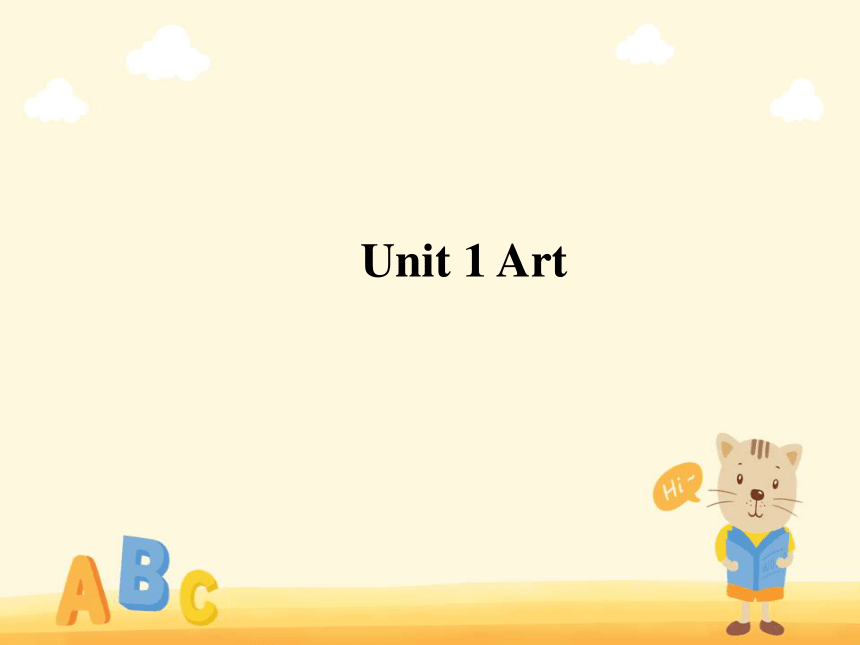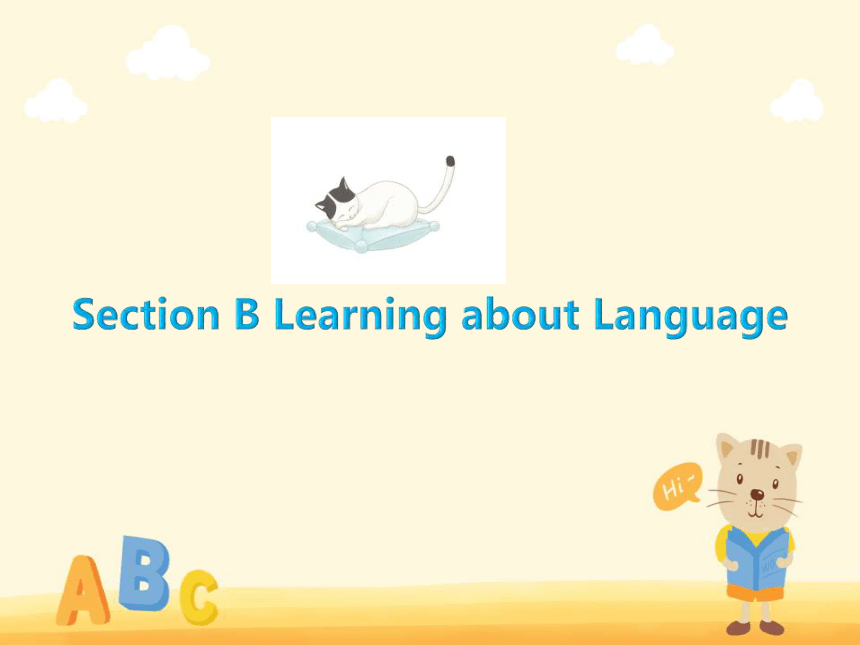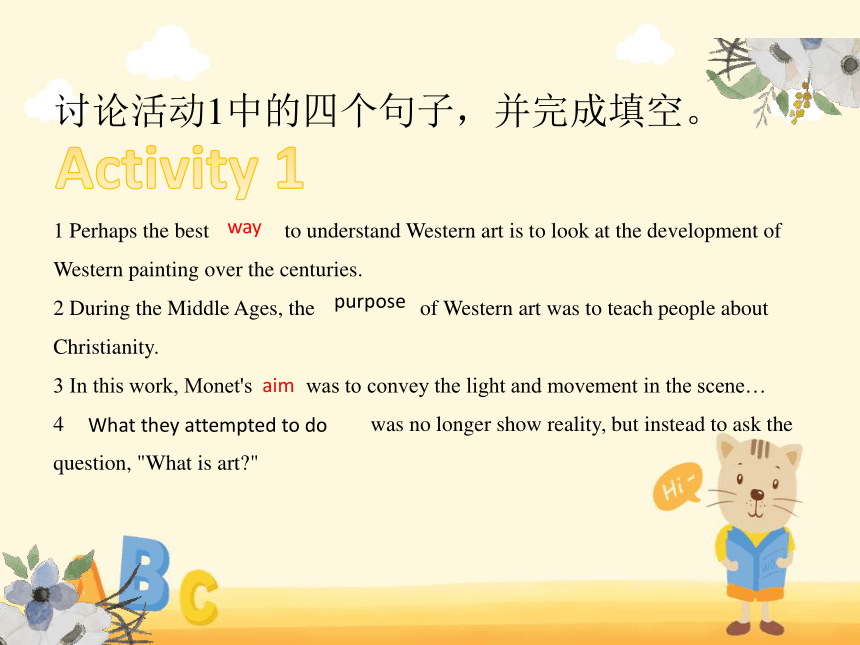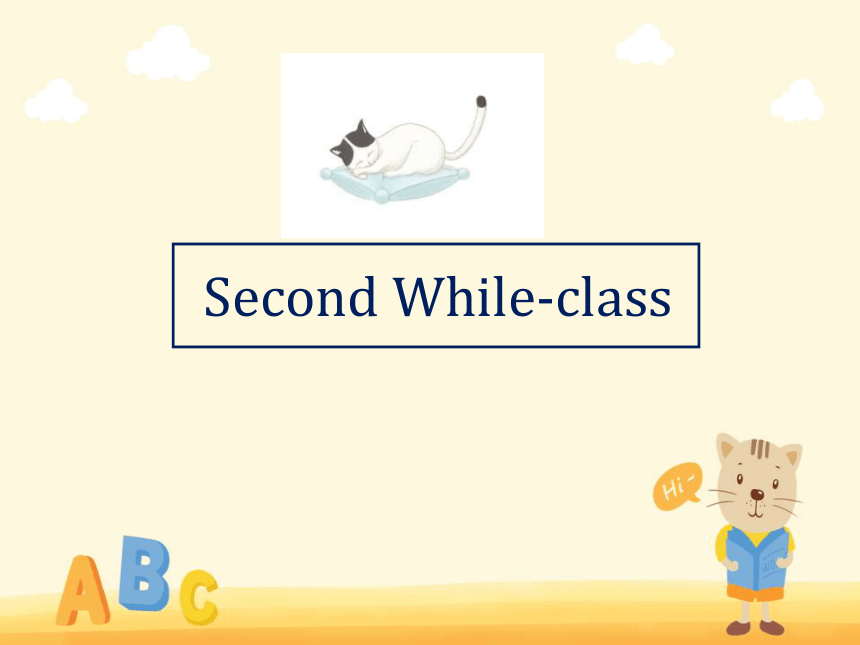人教版(2019)选择性必修第三册Unit 1 Art Section B课件(19张ppt)
文档属性
| 名称 | 人教版(2019)选择性必修第三册Unit 1 Art Section B课件(19张ppt) |  | |
| 格式 | pptx | ||
| 文件大小 | 932.9KB | ||
| 资源类型 | 教案 | ||
| 版本资源 | 人教版(2019) | ||
| 科目 | 英语 | ||
| 更新时间 | 2023-03-08 17:45:01 | ||
图片预览







文档简介
(共19张PPT)
Unit 1 Art
Section B Learning about Language
Menu
Leading in
While-class
After-class
First Leading in
1 Perhaps the best to understand Western art is to look at the development of Western painting over the centuries.
2 During the Middle Ages, the of Western art was to teach people about Christianity.
3 In this work, Monet's was to convey the light and movement in the scene…
4 was no longer show reality, but instead to ask the question, "What is art "
way
purpose
aim
What they attempted to do
讨论活动1中的四个句子,并完成填空。
Activity 1
Second While-class
Our plan is to make better use of these materials.
What I would suggest is to ask your father for his opinion.
The next step is to make sure that you know exactly what is required.
He was to die in a shipwreck and to leave his wife and two children.
找出下列句子中的表语并说出在句子中的作用。
(说明主语)
(说明主语)
(表示目的)
(表示结果)
动词不定式(短语)作表语相当于名词作表语。它和主语处在同等地位,所指的或是和主语一样的东西,或是主语产生的结果。常常可以将主、表交换位置,句子的意义不变。
一、动词不定式(短语)作表语的用法
1.主语是以aim,suggestion,duty,hope,idea,intention,plan,purpose,the way to do sth等为中心的名词词组时,或者以what引导的名词性分句表示,一般用动词不定式作表语说明主语的内容。
动词不定式(短语)作表语
2.表示目的。
The next step is to make sure that you know exactly what is required.
下一步你要真正弄清楚需要的是什么。
3.表示事态发展的结果、预期的结果、不幸的命运或预言。
He was to die in a shipwreck and to leave his wife and two children.
后来他在一次船只失事中丧生,留下了妻子和两个孩子。
4.用于被动语态,相当于can/could,should,ought to,must,具有情态意义。
The regulations are to be observed.
规章制度必须遵守。(must)
5.表示"同意、安排、命令、决定、劝告、愿望、意愿、禁止"等。
They are to marry next week.
他们将在下周结婚。(安排)
6.动词不定式(短语)作表语时,可用主动形式表示被动意义。
Who is to blame for the fire?
谁该对此次火灾负责?
二、动词不定式(短语)作表语省略to的情况
动词不定式(短语)作表语时,一般情况下不定式符号to不能省略,但在以下几种情况下可省略不定式符号to:
1.all作主句主语,其后的定语从句中含有实义动词do的某种形式时。
例:
All we need to do is live each day with hope.
我们需要做的就是带着希望过好每一天。
2.what引导的从句作主语,从句中含有实义动词do的某种形式时。
例:
What I want to do is take a holiday right away.
我想马上就去度假。
3.(主句)主语被only,first,one,least或形容词最高级修饰,且其后作定语的从句或短语中含有实义动词do的某种形式时。
例:
In the evening the only thing he did was read the newspaper.
晚上他唯一做的就是看报纸。
三、动词不定式(短语)作表语和v-ing(短语)作表语的区别
1.动词不定式(短语)和v-ing(短语)作表语时,要注意与句子的主语在形式上保持一致,即若句子的主语为v-ing(短语),则表语也应使用v-ing(短语),若主语为动词不定式(短语),则表语也应使用动词不定式(短语)。
例:
To see is to believe.= Seeing is believing.眼见为实。
2.动词不定式(短语)和v-ing(短语)作表语时可换用,但以下情况除外:
(1)当动词所表达的是某一特定的行为,尤其是将来的行为或有待于实现的行为时,通常用动词不定式(短语)作表语。
Her best wish is to put her new ideas into practice.
她最大的愿望是将自己的新想法付诸实践。
(2)若动词所表达的并不强调动作,而是表示主语的内容,则通常用v-ing(短语)作表语。
My favorite sport is swimming.
我最喜欢的运动是游泳。
Activity 2
1 The young singer's intention of performing the song was
2 The best way to do business is
3 What the survivors attempted to do was
4 The main purpose of art education in schools is
5 The aim of the two leaders at the conference was
6 For a humble person, one of the hardest things might be
7 When you are faced with a serious decision, my suggestion is
8 The mother believes her duty is
9 All he wanted after a tiring day was
A to build trust between you and your
client
B to achieve permanent peace between
their two countries
C to build a memorial to the heroes who
saved their lives
D to share his love for rock music with
his fans
E to be left alone
F to criticise other people
G to inspire students to be creative
H to listen to your own inner voice
I to raise her son to become a man with
a noble mind and a generous heart
Third After-class
Make conversations using the following questions and sentence patterns.
1 What's your biggest dream/ambition in life
2 How are you going to make your dream come true
3 How are you going to achieve your goal
4 Do you have any plans
5 What might be difficult for you
6 How are you going to deal with...
My biggest dream/ambition in life is to…
I think all I have to do is…
My plan is to…
I think one of the hardest things might be…
I guess the best way to...is…
Summary
一、动词不定式(短语)作表语的用法
1.主语是以aim,suggestion,duty,hope,idea,intention,plan,purpose,the way to do sth等为中心的名词词组时,或者以what引导的名词性分句表示,一般用动词不定式作表语说明主语的内容。
2.表示目的。
3.表示事态发展的结果、预期的结果、不幸的命运或预言。
4.用于被动语态,相当于can/could,should,ought to,must,具有情态意义。
5.表示"同意、安排、命令、决定、劝告、愿望、意愿、禁止"等。
6.动词不定式(短语)作表语时,可用主动形式表示被动意义。
二、动词不定式(短语)作表语省略to的情况
三、动词不定式(短语)作表语和v-ing(短语)作表语的区别
Thank you!
Unit 1 Art
Section B Learning about Language
Menu
Leading in
While-class
After-class
First Leading in
1 Perhaps the best to understand Western art is to look at the development of Western painting over the centuries.
2 During the Middle Ages, the of Western art was to teach people about Christianity.
3 In this work, Monet's was to convey the light and movement in the scene…
4 was no longer show reality, but instead to ask the question, "What is art "
way
purpose
aim
What they attempted to do
讨论活动1中的四个句子,并完成填空。
Activity 1
Second While-class
Our plan is to make better use of these materials.
What I would suggest is to ask your father for his opinion.
The next step is to make sure that you know exactly what is required.
He was to die in a shipwreck and to leave his wife and two children.
找出下列句子中的表语并说出在句子中的作用。
(说明主语)
(说明主语)
(表示目的)
(表示结果)
动词不定式(短语)作表语相当于名词作表语。它和主语处在同等地位,所指的或是和主语一样的东西,或是主语产生的结果。常常可以将主、表交换位置,句子的意义不变。
一、动词不定式(短语)作表语的用法
1.主语是以aim,suggestion,duty,hope,idea,intention,plan,purpose,the way to do sth等为中心的名词词组时,或者以what引导的名词性分句表示,一般用动词不定式作表语说明主语的内容。
动词不定式(短语)作表语
2.表示目的。
The next step is to make sure that you know exactly what is required.
下一步你要真正弄清楚需要的是什么。
3.表示事态发展的结果、预期的结果、不幸的命运或预言。
He was to die in a shipwreck and to leave his wife and two children.
后来他在一次船只失事中丧生,留下了妻子和两个孩子。
4.用于被动语态,相当于can/could,should,ought to,must,具有情态意义。
The regulations are to be observed.
规章制度必须遵守。(must)
5.表示"同意、安排、命令、决定、劝告、愿望、意愿、禁止"等。
They are to marry next week.
他们将在下周结婚。(安排)
6.动词不定式(短语)作表语时,可用主动形式表示被动意义。
Who is to blame for the fire?
谁该对此次火灾负责?
二、动词不定式(短语)作表语省略to的情况
动词不定式(短语)作表语时,一般情况下不定式符号to不能省略,但在以下几种情况下可省略不定式符号to:
1.all作主句主语,其后的定语从句中含有实义动词do的某种形式时。
例:
All we need to do is live each day with hope.
我们需要做的就是带着希望过好每一天。
2.what引导的从句作主语,从句中含有实义动词do的某种形式时。
例:
What I want to do is take a holiday right away.
我想马上就去度假。
3.(主句)主语被only,first,one,least或形容词最高级修饰,且其后作定语的从句或短语中含有实义动词do的某种形式时。
例:
In the evening the only thing he did was read the newspaper.
晚上他唯一做的就是看报纸。
三、动词不定式(短语)作表语和v-ing(短语)作表语的区别
1.动词不定式(短语)和v-ing(短语)作表语时,要注意与句子的主语在形式上保持一致,即若句子的主语为v-ing(短语),则表语也应使用v-ing(短语),若主语为动词不定式(短语),则表语也应使用动词不定式(短语)。
例:
To see is to believe.= Seeing is believing.眼见为实。
2.动词不定式(短语)和v-ing(短语)作表语时可换用,但以下情况除外:
(1)当动词所表达的是某一特定的行为,尤其是将来的行为或有待于实现的行为时,通常用动词不定式(短语)作表语。
Her best wish is to put her new ideas into practice.
她最大的愿望是将自己的新想法付诸实践。
(2)若动词所表达的并不强调动作,而是表示主语的内容,则通常用v-ing(短语)作表语。
My favorite sport is swimming.
我最喜欢的运动是游泳。
Activity 2
1 The young singer's intention of performing the song was
2 The best way to do business is
3 What the survivors attempted to do was
4 The main purpose of art education in schools is
5 The aim of the two leaders at the conference was
6 For a humble person, one of the hardest things might be
7 When you are faced with a serious decision, my suggestion is
8 The mother believes her duty is
9 All he wanted after a tiring day was
A to build trust between you and your
client
B to achieve permanent peace between
their two countries
C to build a memorial to the heroes who
saved their lives
D to share his love for rock music with
his fans
E to be left alone
F to criticise other people
G to inspire students to be creative
H to listen to your own inner voice
I to raise her son to become a man with
a noble mind and a generous heart
Third After-class
Make conversations using the following questions and sentence patterns.
1 What's your biggest dream/ambition in life
2 How are you going to make your dream come true
3 How are you going to achieve your goal
4 Do you have any plans
5 What might be difficult for you
6 How are you going to deal with...
My biggest dream/ambition in life is to…
I think all I have to do is…
My plan is to…
I think one of the hardest things might be…
I guess the best way to...is…
Summary
一、动词不定式(短语)作表语的用法
1.主语是以aim,suggestion,duty,hope,idea,intention,plan,purpose,the way to do sth等为中心的名词词组时,或者以what引导的名词性分句表示,一般用动词不定式作表语说明主语的内容。
2.表示目的。
3.表示事态发展的结果、预期的结果、不幸的命运或预言。
4.用于被动语态,相当于can/could,should,ought to,must,具有情态意义。
5.表示"同意、安排、命令、决定、劝告、愿望、意愿、禁止"等。
6.动词不定式(短语)作表语时,可用主动形式表示被动意义。
二、动词不定式(短语)作表语省略to的情况
三、动词不定式(短语)作表语和v-ing(短语)作表语的区别
Thank you!
